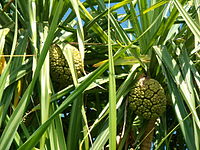Why the Ketaki flower was cursed by gods
Contents
The flowers of Ketaki
| Discussed species | Pandanus fascicularis, Kewdā केवड़ा, Thaazhampoo தாழம்பூ, Kaitha കൈത or Ketaki केतकी |
|---|---|
| Description | Screw Pine is a species native to southern Asia, from southern India east to Taiwan and the Ryukyu Islands south of Japan, and south to Indonesia. It is a shrub with fragrant flowers. (Wikipedia) |
The flowers of Ketaki assume special significance in Indian culture. The flowers are highly fragrant and are even used for making aromatic oils and perfumes, but they are not used as offerings to Gods. There is an interesting mythological story in the Shiva Purana explaining why that is the case:
At the beginning of time in Cosmos, Vishnu and Brahmā approached a huge Shiva linga and set out to find its beginning and end. Vishnu advanced to seek the end and Brahma the beginning. Taking the form of a boar, Vishnu began digging downwards into the earth, while Brahma took the form of a swan and began flying upwards. However, neither could find his appointed destination. Vishnu, satisfied, came up to Shiva and bowed down to him as a swarupa of Brahman. Brahmā did not give up so easily. As he was going up, he saw a ketaki flower, dear to Shiva, floating down. Ketaki told Shiva that she had been placed at the top of the Shiva linga[1][2]. Brahma's ego forced him to ask the flower to bear false witness about Brahmā's discovery of Shiva's beginning. When Brahmā told his tale, Shiva, the all-knowing, was angered by the former's ego. Shiva thus cursed him that no being in the three worlds will worship him. The flower of Ketaki, for bearing false witness, was cursed to be never used for the worship of Shiva.
The Gods cursed the Ketaki flower, which probably was a boon for mankind :). Ketaki flowers, as mentioned earlier, are very fragrant and are used extensively in perfumes and oils[3]. Flower extracts are used as attars in marriages. The fragrance is used in hair oils, lotions, soaps, tobacco, cosmetics, syrups and sweet dishes. The leaves of Ketaki have medicinal value and are used as condiments as well[4].
Additional media
References
- ^ ShivaMahapuran Accessdate=Oct 4, 2011
- ^ Flowers of India - Flowers in Ancient Literature
- ^ Cultivation of Ketaki and oil extraction Accessdate=Oct 4, 2011
- ^ Ketaki flower - Tribune India Accessdate=Oct 4, 2011
Comments
blog comments powered by DisqusMore notes like this
| |||||||||||||||||||||||||||||||||||||||||||||||||||||||||||||||||||||||||||||||||||||
Only 15 articles are shown in this list. A total of 64 articles in the database as of this moment. For the complete list, click on further results on the bottom right corner of the above table.
Semantic tags
- Browse all Semantic Tags associated with this page
- Find more pages and articles created by the community by clicking this link.
| Title | Why the Ketaki flower was cursed by gods | Article is on this general topic | Mythological stories | Author | Gaurav Moghe |
|---|---|---|---|---|---|
| Specific location(s) where study was conducted | Not noted | General region where study was conducted | Not noted | State where study was conducted | Pan-India |
| Institutional affiliation | Not noted | Institution located at | Not noted | Institution based around | Not noted |
| Species Group | Plants | User ID | User:Gauravm | Page creation date | 2011/10/04 |
Share this page:
